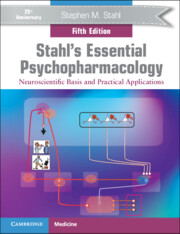Book contents
- Stahl’s Essential Psychopharmacology
- Additional material
- Stahl’s Essential Psychopharmacology
- Copyright page
- Contents
- Preface to the Fifth Edition
- CME Information
- 1 Chemical Neurotransmission
- 2 Transporters, Receptors, and Enzymes as Targets of Psychopharmacological Drug Action
- 3 Ion Channels as Targets of Psychopharmacological Drug Action
- 4 Psychosis, Schizophrenia, and the Neurotransmitter Networks Dopamine, Serotonin, and Glutamate
- 5 Targeting Dopamine and Serotonin Receptors for Psychosis, Mood, and Beyond: So-Called “Antipsychotics”
- 6 Mood Disorders and the Neurotransmitter Networks Norepinephrine and γ-Aminobutyric Acid (GABA)
- 7 Treatments for Mood Disorders: So-Called “Antidepressants” and “Mood Stabilizers”
- 8 Anxiety, Trauma, and Treatment
- 9 Chronic Pain and Its Treatment
- 10 Disorders of Sleep and Wakefulness and Their Treatment: Neurotransmitter Networks for Histamine and Orexin
- 11 Attention Deficit Hyperactivity Disorder and Its Treatment
- 12 Dementia: Causes, Symptomatic Treatments, and the Neurotransmitter Network Acetylcholine
- 13 Impulsivity, Compulsivity, and Addiction
- Suggested Reading and Selected References
- Index
2 - Transporters, Receptors, and Enzymes as Targets of Psychopharmacological Drug Action
- Stahl’s Essential Psychopharmacology
- Additional material
- Stahl’s Essential Psychopharmacology
- Copyright page
- Contents
- Preface to the Fifth Edition
- CME Information
- 1 Chemical Neurotransmission
- 2 Transporters, Receptors, and Enzymes as Targets of Psychopharmacological Drug Action
- 3 Ion Channels as Targets of Psychopharmacological Drug Action
- 4 Psychosis, Schizophrenia, and the Neurotransmitter Networks Dopamine, Serotonin, and Glutamate
- 5 Targeting Dopamine and Serotonin Receptors for Psychosis, Mood, and Beyond: So-Called “Antipsychotics”
- 6 Mood Disorders and the Neurotransmitter Networks Norepinephrine and γ-Aminobutyric Acid (GABA)
- 7 Treatments for Mood Disorders: So-Called “Antidepressants” and “Mood Stabilizers”
- 8 Anxiety, Trauma, and Treatment
- 9 Chronic Pain and Its Treatment
- 10 Disorders of Sleep and Wakefulness and Their Treatment: Neurotransmitter Networks for Histamine and Orexin
- 11 Attention Deficit Hyperactivity Disorder and Its Treatment
- 12 Dementia: Causes, Symptomatic Treatments, and the Neurotransmitter Network Acetylcholine
- 13 Impulsivity, Compulsivity, and Addiction
- Suggested Reading and Selected References
- Index
Summary
Psychotropic drugs have many mechanisms of action, but they all target specific molecular sites that have profound effects upon neurotransmission. It is thus necessary to understand the anatomical infrastructure and chemical substrates of neurotransmission (Chapter 1) in order to grasp how psychotropic drugs work. Although there are over 100 essential psychotropic drugs utilized in clinical practice today (see Stahl’s Essential Psychopharmacology: the Prescriber’s Guide), there are only a few sites of action for all these therapeutic agents (Figure 2-1). Specifically, about a third of psychotropic drugs target one of the transporters for a neurotransmitter; another third target receptors coupled to G proteins; and perhaps only 10% target enzymes. All three of these sites of action will be discussed in this chapter. The balance of psychotropic drugs target various types of ion channels, which will be discussed in Chapter 3. Thus, mastering how just a few molecular sites regulate neurotransmission allows the psychopharmacologist to understand the theories about the mechanisms of action of virtually all psychopharmacological agents.
- Type
- Chapter
- Information
- Stahl's Essential PsychopharmacologyNeuroscientific Basis and Practical Applications, pp. 29 - 50Publisher: Cambridge University PressPrint publication year: 2022



